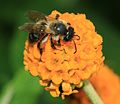Buddleja globosa
| Buddleja globosa | |
|---|---|
 | |
| Scientific classification | |
| Kingdom: | Plantae |
| Clade: | Tracheophytes |
| Clade: | Angiosperms |
| Clade: | Eudicots |
| Clade: | Asterids |
| Order: | Lamiales |
| Family: | Scrophulariaceae |
| Genus: | Buddleja |
| Species: | B. globosa |
| Binomial name | |
| Buddleja globosa Hope | |
| Synonyms | |
| |
Buddleja globosa, also known as the orange-ball-tree,[1] orange ball buddleja, and matico, is a species of flowering plant endemic to Chile and Argentina, where it grows in dry and moist forest, from sea level to 2,000 m.[2] The species was first described and named by Hope in 1782.[3]
Description
Buddleja globosa is a large shrub to 5 m (16 ft) tall, with grey fissured bark. The young branches are subquadrangular and tomentose, bearing sessile or subsessile lanceolate or elliptic leaves 5–15 cm long by 2–6 cm wide, glabrescent and bullate above and tomentose below. The deep-yellow to orange leafy-bracted inflorescences comprise one terminal and < 7 pairs of pedunculate globose heads, 1.2–2.8 cm in diameter, each with 30–50 flowers, heavily honey-scented. Ploidy: 2n = 38 (diploid).[2]
In common with many New World Buddlejaceae species B. globosa is dioecious: although the flowers appear hermaphrodite in having both male and female parts, only the anthers or pistils are functional in a single plant ('cryptically dioecious').[2]
Cultivation
Buddleja globosa was first introduced to the United Kingdom from Chile in 1774, and is now commonly grown as an ornamental and landscape shrub in temperate regions. Unlike B. davidii, introduced over a century later, B. globosa is not invasive owing to its wingless seeds.[2] Hardiness: USDA zones 5–9, RHS H5.[4]
The plant was accorded the Royal Horticultural Society's Award of Garden Merit (record 687) in 1993.[5]
Cultivars
- Buddleja globosa 'Cally Orange'
- Buddleja globosa 'Cannington Gold'
- Buddleja globosa 'Lemon Ball'
- Buddleja globosa 'Los Lagos'
- Buddleja globosa 'HCM98017'[4]
Hybrids
- Buddleja × weyeriana
B. globosa was hybridized with B. davidii var. magnifica by van de Weyer at Corfe Castle, England, during the First World War, the first cross between an Asiatic and an American species. The F2, rather than F1, generation are named × weyeriana; there are several popular cultivars, notably 'Sungold'.[2]
Uses
Folk medicine attributes to B. globosa wound healing properties, and the infusion of the leaves is used topically for the treatment of wounds, burns and external and internal ulcers. Chemical studies of this species have allowed to isolate glycosidic flavonoids,[6] phenylethanoids including verbascoside,[7] iridoids,[8] triterpenoids,[9] di and sesquiterpenoid s.[10][11]
Gallery
-
 Detail of single globose flower cluster
Detail of single globose flower cluster -
 Andrena sp. pollinating spherical flower cluster
Andrena sp. pollinating spherical flower cluster -
 Longshot of mature specimen, Bayswater, London, U.K.
Longshot of mature specimen, Bayswater, London, U.K. -
 Mid-shot of Bayswater specimen
Mid-shot of Bayswater specimen
References
- ^ BSBI List 2007 (xls). Botanical Society of Britain and Ireland. Archived from the original (xls) on 2015-06-26. Retrieved 2014-10-17.
- ^ a b c d e Norman, E. M. (2000). Buddlejaceae. Flora Neotropica 81. New York Botanical Garden, USA
- ^ Hope, J. (1782). Verh. Holl. Maatsch. Weetensch. Haarlem 20(2): 417-418. t.11. 1782.
- ^ a b Stuart, D. (2006). Buddlejas. Plant Collector Guide. Timber Press, Oregon, USA. ISBN 978-0-88192-688-0
- ^ "RHS Plantfinder - Buddleja globosa". Royal Horticultural Society. Retrieved 21 January 2018.
- ^ Marín et al., 1979
- ^ Pardo F, Perich F, Villarroel L, Torres R (August 1993). "Isolation of verbascoside, an antimicrobial constituent of Buddleja globosa leaves". J Ethnopharmacol. 39 (3): 221–222. doi:10.1016/0378-8741(93)90041-3. PMID 8258981.
- ^ Houghton y Hikino, 1989
- ^ López et al., 1979
- ^ Houghton et al., 1996
- ^ Liao et al., 1999
- Images of Buddleja globosa in Chileflora, seed provider
- Backhouse N, Rosales L, Apablaza C, et al. (March 2008). "Analgesic, anti-inflammatory and antioxidant properties of Buddleja globosa, Buddlejaceae". J Ethnopharmacol. 116 (2): 263–269. doi:10.1016/j.jep.2007.11.025. PMID 18164566.
- Houghton PJ, Hikino H (April 1989). "Anti-hepatotoxic activity of extracts and constituents of Buddleja species". Planta Med. 55 (2): 123–126. doi:10.1055/s-2006-961903. PMID 2748726.
- Houghton, P (1996). "Buddlejone, a diterpene from Buddleja albiflora". Phytochemistry. 42 (2): 485–488. doi:10.1016/0031-9422(96)00001-5.
- Liao YH, Houghton PJ, Hoult JR (September 1999). "Novel and known constituents from Buddleja species and their activity against leukocyte eicosanoid generation". J. Nat. Prod. 62 (9): 1241–1245. doi:10.1021/np990092+. PMID 10514305.
- Olmstead, RG; Depamphilis, CW; Wolfe, AD; Young, ND; Elisons, WJ; Reeves, PA (2001). "Disintegration of the Scrophulariaceae". Am J Bot. 88 (2): 348–361. doi:10.2307/2657024. JSTOR 2657024. PMID 11222255.













